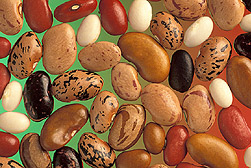 In 1989, farmers in Florida, Indiana and South Carolina began noticing a disease that was rapidly spreading through their watermelon crops1. Large, dark lesions and bruises appeared on the fruit and leaves exhibited brown discolouration; all that remained of severely infected fruit was a pulpy, inedible mess. In damp conditions the disease proliferated quickly and in some areas 100% of crops were destroyed. Economic costs have been difficult to estimate, but the damage wrought to farmers across significant parts of the US was devastating. The disease – named bacterial fruit blotch – was caused by the seedborne bacterium Acidovorax citrulli.
In 1989, farmers in Florida, Indiana and South Carolina began noticing a disease that was rapidly spreading through their watermelon crops1. Large, dark lesions and bruises appeared on the fruit and leaves exhibited brown discolouration; all that remained of severely infected fruit was a pulpy, inedible mess. In damp conditions the disease proliferated quickly and in some areas 100% of crops were destroyed. Economic costs have been difficult to estimate, but the damage wrought to farmers across significant parts of the US was devastating. The disease – named bacterial fruit blotch – was caused by the seedborne bacterium Acidovorax citrulli.
A seedborne disease is one that can be carried from one plant to another via its seeds. The pathogen does not have to be a bacterium, as in the case of bacterial fruit blotch, but can be a fungus, a virus or even a nematode worm. By commandeering the ability of seeds to disperse over long distances – which is, after all, part of a seed’s job – these pathogens are able to spread with worrying speed.
Ironically, the international trade in plant seeds is often the greatest unwitting ally of seedborne diseases. The industry, which encompasses the development, production, import and export of seeds, is truly global in scope. Business is booming: in 2009 the global seed trade was worth US $37 billion and, despite the current economic uncertainty, it has continued to grow at a steady pace since2. Recent advances in genetically engineering seeds are expected fuel a further boost to the industry in the coming years.
However, as the global seed trade grows, so too does the risk that seedborne diseases will be imported from one country into another3. For instance, France regularly imports carrot seed from New Zealand4, which imports rice seed from Nigeria5, which imports cotton seed from India6 – and so on. As it can only take a few infected seeds in a thousand for a disease to become established in a new country, the risk to agriculture worldwide from seedborne diseases is very real.
This risk was highlighted by bacterial fruit blotch: soon after its initial outbreak in North America, imports of infested seed meant that it quickly began to spread around the world. By the mid-1990s it had been identified in over a dozen states in the US. It soon reached Central and South America, and in the past decade it has arrived in Australia and multiple countries within Europe and Asia1,7.
The challenge that therefore faces scientists and the seed trade is how to tackle the threat of seedborne outbreaks. Already there are very strict precautions in place: imports of seed must be quarantined for a set number of days – often totalling several months – and checked for any sign of infestation8. This process is aided by organisations like the International Seed Testing Association, which promote uniform methods of seed health testing worldwide9.
An increasing understanding of seedborne pathogens and diseases has brought advances in the treatment and prevention of them, and will hopefully continue to do so long into the future. Given the seed trade’s vital importance in supporting the livelihoods of millions of people across the globe, its continued growth should be welcomed10. The hope now is that the scientific community can keep up with such rapid growth in the fight against seedborne disease.
As part of this fight, in a project sponsored by Plant Protection Station, Ministry of Agriculture, Forestry and Fisheries, Japan, CABI has recently updated over a hundred datasheets in the Crop Protection Compendium relating to the control of a wide range of seedborne diseases. In addition, CAB abstracts contains a vast amount of information relating to all aspects of seedborne diseases and pathogens.
References:
1. Acidovorax citrulli. EPPO, 2009. http://www.eppo.int/QUARANTINE/Alert_List/bacteria/Acidovorax_citrulli.htm
2. Global seeds market. Koncept Analytics, 2012. http://www.slideshare.net/prkonceptanalytics/global-seeds-market-report-2012-edition-13737643
3. Sanitary and phytosanitary measures under the WTO and their effects on the local seed trade in Asia. Pirzada, SWH. ASPA technical report, 2003. http://www.apsaseed.org/docs/7a98b582/TR_No._35_Sanitary_and_Phytosanitary_Measures_Under_the_WTO_and_Their_Effects_on_the_Seed_Trade_in_Asia.pdf
4. Fresh Facts. Horticulture New Zealand and Plant and Food Research, 2011. http://www.freshfacts.co.nz/file/fresh-facts-2011.pdf
5. Country Profiles: New Zealand. Food and Agriculture Organisation of the United Nations, 2012. http://www.fao.org/countryprofiles/index/en/?iso3=NZL
6. Nigeria to import tractors, seeds from India. Financial Express, 2003. http://www.financialexpress.com/news/nigeria-to-import-tractors-seeds-from-india/91169/
7. Bacterial Fruit Blotch: a commercial grower’s guide. ASTA. http://www.amseed.com/pdfs/DiseaseGuide-BFB-English.pdf
8. Guidelines on legislation, impact practises and plant quarantine for botanic gardens and kindred institutes. Long H, Inches F and Treseder K (eds.). PlantNetwork, 2006. http://plantnetwork.org/wordpress/wp-content/uploads/3416/planthealth.pdf
9. International Seed Testing Association. ISTA, 2012. http://www.seedtest.org/en/home.html
10. Responding to the challenges of a changing world: the role of new plant varieties and high quality seed in agriculture. Second World Seed Conference, 2009. http://www.upov.int/about/en/pdf/wsc_leaflet_outcome.pdf
Related News & Blogs
CABI scientist defends PhD thesis on risks of pest and disease movement via plant and seed exchanges
CABI scientist Dr Iva Franić has successfully defended her PhD thesis looking at the risks of pest and disease movement via plant and seed exchanges. Dr Franić, co-supervised by Dr René Eschen, Research Scientist, Ecosystems Management, and Risk Analys…
30 March 2020


